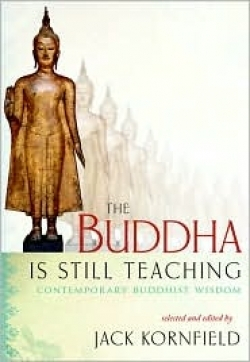
The Buddha is Still Teaching
Contemporary Buddhist Wisdom
“I teach only two things—suffering and the end of suffering,” said the Buddha. Through the Dharma—truth or path to truth—he explained that suffering originates in the clinging mind, and that suffering is released by an enlightened mind. In The Buddha is Still Teaching, editors Jack Kornfield and Noelle Oxenhandler present material that answers the Buddha’s call to continuously make the Dharma new, for new ages and new places. This compilation borrows and adapts work from seventy-five teachers, dating back to Gandhi (1939), Hesse (1951), and Krishnamurti (1969), but mostly excerpts work written during the past twenty years. Contributors come from both east (the Dalai Lama, Shunryu Suzuki, and Thich Nhat Hanh, among others) and west (including Philip Kapleau, Sharon Salzberg, and Alan Watts). The shortest entry is the cryptic line, “Your mind is all stories,” from Dipa Ma, but most entries are several paragraphs or more. Several poems, most notably by Rick Fields and Gary Snyder, complement this collection.
Jack Kornfield is a trained Buddhist monk and has earned a doctorate in clinical psyschology. Cofounder, in 1974, of the Insight Meditation Society, and author of several books, Kornfeld’s influence in introducing Buddhism to the West has been considerable. Noelle Oxenhandler is also a longtime practicing Buddhist who has published several books of nonfiction and many articles in such periodicals as The New Yorker, Vogue, and The Oprah Magazine.
The organization and style of these presentations will be appreciated by both the devotee and the uninitiated. Four sections—Wise Understanding, Compassion and Courage, Freedom, and Enlightenment (and the Bodhisattva Path)—arrange material that is at times dense and abstract, but is often illuminated by an allegory or illustration on a succeeding page. The grasping, clinging mind that the Buddhist associates with suffering, for example, is on one page compared to the ocean’s surface, with its waves of varying sizes; on another, it is personified in the seven-year-old “who vigilantly watches to see who got more.” Mindfulness training is compared to learning to swim, while, in another excerpt, a clear forest pool symbolizes the mind at rest. Parables and personal stories also serve as teaching tools. In one story, a Vietnam veteran recalls how a meditation retreat he attended, eight years after his tour had ended, helped him to “release the inner demons of war” by acknowledging the memories that he had previously been unable to face. “While the memories have stayed with me,” he observes, “the nightmares have not.”
Reviewed by
Joe Taylor
Disclosure: This article is not an endorsement, but a review. The publisher of this book provided free copies of the book to have their book reviewed by a professional reviewer. No fee was paid by the publisher for this review. Foreword Reviews only recommends books that we love. Foreword Magazine, Inc. is disclosing this in accordance with the Federal Trade Commission’s 16 CFR, Part 255.
